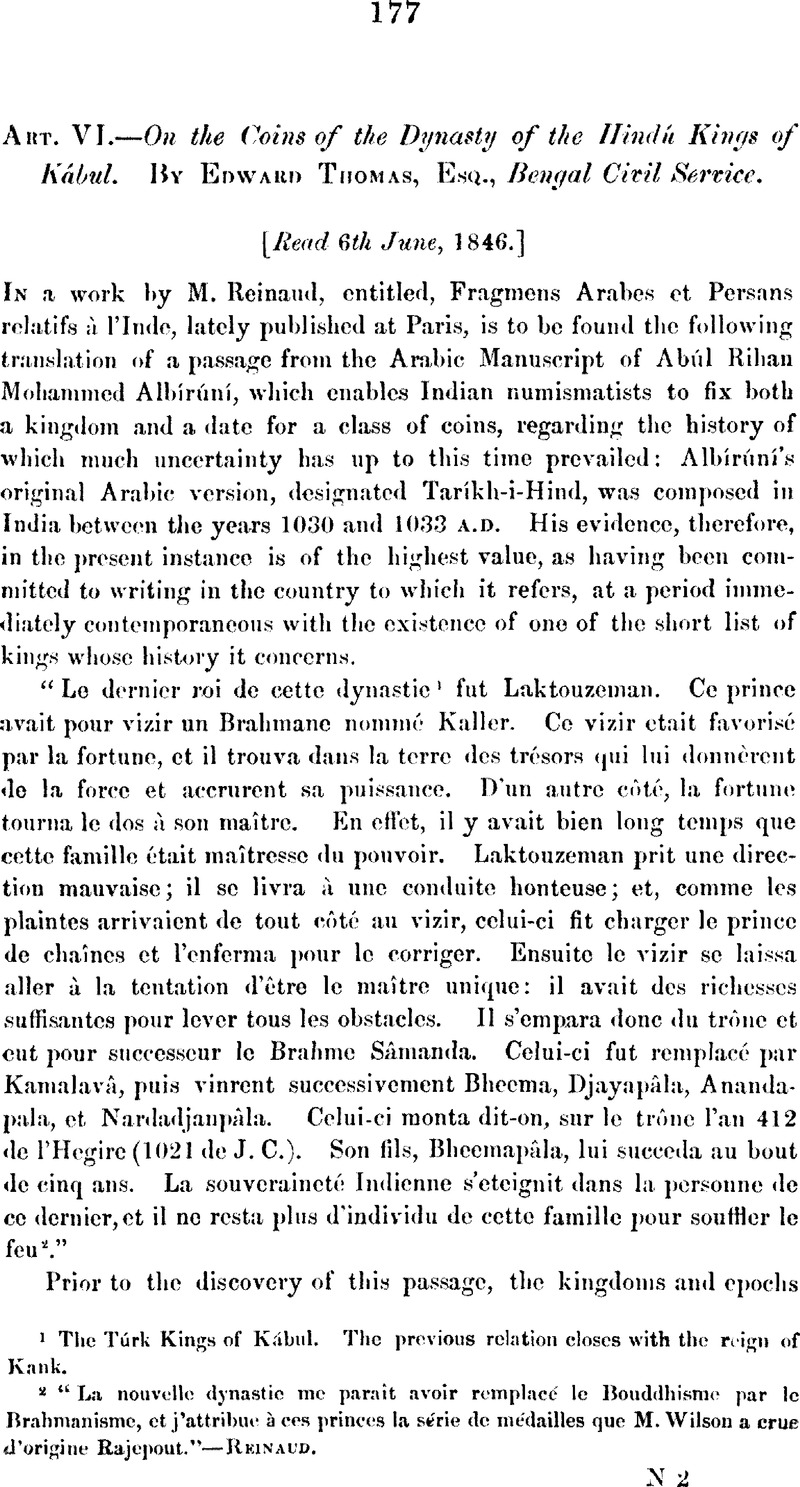No CrossRef data available.
Article contents
Art. VI.—On the Coins of the Dynasty of the Hindú Kings of Kábul
Published online by Cambridge University Press: 14 March 2011
Abstract

- Type
- Original Communications
- Information
- Copyright
- Copyright © The Royal Asiatic Society 1848
References
page 177 note 1 The Túrk Kings of Kábul. The previous relation closes with the reign of Kank.
page 177 note 2 “La nouvelle dynastie me parait avoir remplacé le Bouddhisme par le Brahmanisme, et j'sattribue à ces princes la série de médailles que M. Wilson a crue d'origine Rajepout.”—Reinaud.
page 179 note 1 For the notice of this discovery, as bearing upon the era of the Brahman kings of Kábul, we are indebted to M. A. de Longperier, whose valuable communication on this subject is printed at the end of M. Reinaud's work.
page 183 note 1 Vide Journal Royal Asiatic Society, No. XII., Art. XIV.
page 184 note 1 Journal Asiatic Society of Bengal, Useful Tables.
page 188 note 1 See also Figs. 21 and 28, Plate XIX., Ariana Antiqua.
page 188 note 2 Were it not venturing beyond what the strict reading of the inscription on this coin altogether permits, it might well be attributed to Sóméswar, the Chohán King of Ajmír, the fourth in descent from the great Visala dev.
In the transition state of the Devanagari alphabet at this period, the initial letter of the name, which undoubtedly (referring to the modern forms) looks more like a ![]() than any other consonant, may possibly have been used to represent an
than any other consonant, may possibly have been used to represent an ![]() and what appears of the remainder of the word tallies well with
and what appears of the remainder of the word tallies well with ![]() “Someswar dev.” Vide Tod, Vol. I. p. 225; and Vol. II. p, 451.Google Scholar
“Someswar dev.” Vide Tod, Vol. I. p. 225; and Vol. II. p, 451.Google Scholar
page 192 note 1 This MS. (No. 7628, Addit.) is also a very ancient and seemingly trustworthy copy. It is said to have been once the property of the great Oljáitú Khán himself, under whose auspices part of the work was written. Be this as it may, there seems good reason to believe that it was once owned by Shah Rokh, the son of Tímúr. The MS. is the work of different hands, and badly written at the part quoted below.
page 193 note 1 For full accounts of this manuscript, vide Journal of the Royal Asiatic Society, No. XI., p. 20.
page 193 note 2 Cabul, Elphinstone's, Vol. II., p. 376.Google Scholar
page 193 note 3 Bokhara, Burnes's, Vol. II., p. 209, 8vo. edit.Google Scholar
page 194 note 1 Sic in orig.
page 194 note 2 Jámi-al-Tawáríkh, Part III., Sec. 5, Royal Asiatic Society.
page 194 note 3 This translation is from the pen of Mr. H. T. Prinsep.
page 194 note 4 ![]()
page 195 note 1 ![]()
page 195 note 2 ![]()
page 195 note 3 No. 119, Royal Asiatic Society, and a copy of Sir G. Ouseley's.
page 195 note 4 Sic in orig.
page 195 note 5 Taríkh-i-Binákití. Brit. Museum: Rich Coll., No. 7627.
page 197 note * Mentioned as king of Kanoúj, and contemporary with Rajapal of Benares. This last came to the throne in 1070. Madanpál is also recorded in inscriptions as king of Kanóuj in 1096 A.D. Vide Bird's Guzrat, and Useful Tables.
page 197 note † Ferishtah, Tod
page 198 note 1 It has been considered unnecessary to introduce a coin of Mohammed bin Sám of this type, as the piece, here given resembles his coins, from whence it is derived, in every respect except the name it bears.


